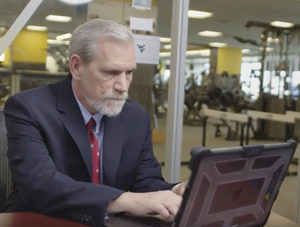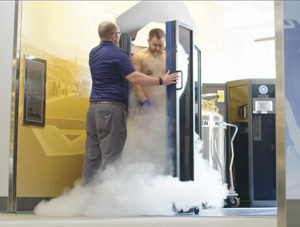By Blair Dowler

After joining the newly established West Virginia University (WVU) Rockefeller Neuroscience Institute one year ago, Dr. Scott Galster is now leading the way in human performance research and brain health programs at WVU Medicine and WVU.
Galster, a tenured professor in the department of physiology, pharmacology and neuroscience at the WVU School of Medicine, works under the direction of and alongside Dr. Ali Rezai, the institute’s director. There, Galster has developed AMP—or Athletes, Military and Patients—a comprehensive program that works with the three different populations to maximize brain health and performance.
“I came from the Air Force Research Laboratory, where we were always looking to optimize the performance of our airmen and war fighters across the Department of Defense,” says Galster. “We began looking at elite athletes because they made really good surrogates for military operators, especially in the special operations community, and they didn’t get deployed. We could measure a lot of different things about them. One of the opportunities with this is that we can take that knowledge, continue to work with the military and also start applying it to the patient population.”
According to Rezai, Galster and the human performance team at WVU have over a decade of expertise with military and athletics safety and performance optimization, creating the prime opportunity for advancements. “This world-class team based at the WVU Rockefeller Neuroscience Institute is advancing the science of human performance and recovery and applying it to patients and general population to improve health and wellness,” he says.
The AMP program, the first of its kind in West Virginia, is proving to be much more diverse and robust than similar programs, and it’s already making a difference in the lives of those it targets—athletes, military members and patients—as well as the general public.
Impacts on the Playing Field
Throughout his career, Galster has worked with numerous NCAA and professional sports teams. At WVU, he and his team now work with the football, women’s soccer, volleyball and men’s basketball teams.
When it comes to athletics, the coaches, trainers and athletes worry about fatigue, resilience and recovery. Fatigue is critical because the more fatigued an athlete is, the more prone to injury he or she can be. With recovery, if an athlete works out extremely hard, it’s important to get back to optimal shape in the most efficient way possible. “After a hard practice or workout, a football coach might suggest an ice bath, but that might be the worst thing you can do for a player at that time,” says Galster. “What we are demonstrating is that there are other options that are available like flotation tanks, photobiomodulation, cryogenics and meditation. It depends on what state you’re in and how you need to recover. For example, if your sympathetic and parasympathetic nervous systems are out of balance, I’m going to put you in a flotation tank because that balances them. If you’re extremely fatigued, I’m going to put you in the photobiomodulation table because I need to reduce your oxidative stress at the cellular level.”
Even though the AMP program has not reached a full year yet, WVU’s women’s soccer team is already seeing a major improvement. Thanks to the program’s focus on injury reduction, the team has had approximately 80 percent fewer injuries like ACL tears compared to years past. WVU’s football team has also fully bought into the program for its benefits.
“Working with the football team’s strength and conditioning coaches, they were already pulling great data, but we are upping it,” says Galster. “I think we have set the team up for success. We’re helping them and demonstrating that they can be as ready as possible by game time.”

Results on the Battlefield
When it comes to the military, there are many risks for injury. Some military personnel go through intense, extreme training in order to be part of a special operation’s unit, such as the Navy SEALs, Army Rangers or Air Force Pararescue Team. With this type of training, the likelihood of injury skyrockets.
One common type of injury is heat injury or casualty, where the heart rate goes up to 170 or above and doesn’t come down, often causing trainees to pass out.
Through the program, Galster and his team began identifying sensors to indicate when a trainee is experiencing heat injury. They ultimately decided to use Zephyr, a pod-type device trainees wear on a strap around their chest to monitor their heart rate.
“If we had a class of 20 going on an 8-mile ruck march with 120 pounds on their backs, we would outfit them before their march,” he says. “We would give the instructor who is following them a tablet, and they would be able to monitor their heart rates in real time. We would also do analytics on that heart rate so they know who to pay attention to.”
The ability to maintain a reduction in heat stress, heat injuries and other heat-related problems is a concrete demonstration that the sensing, assessment and augmentation are working.
“We’ve seen a reduction of between 85-100 percent in those conditions,” he says. “It not only saves the Department of Defense a lot of money in training, but it keeps the pipeline open for those trainees as well.”
Benefits in the Medical Field
One of the major opportunities at the WVU Rockefeller Neuroscience Institute is the ability to use the knowledge the staff gains from working with military and athletic populations to help the patient population. Over the last year, Galster and his team have been able to identify addiction and chronic pain—two of the top priority populations they wanted to work with. With the addiction population, the Comprehensive Opioid Addiction Treatment Program, known as COAT, has allowed the team to work with different groups of that population, including people who have been clean and sober for more than 90 days.
“When they meet with our therapist every other week, our therapist will say, ‘Hey, how’s it going? How have the last two weeks been?’ Typically, the answer is, ‘Fine’ or some kind of vanilla response,” says Galster. “What we are doing now is providing wearable devices so I can track their heart rate, their activity and their sleep and look at their stress response. I’m able to then ask them about what was going on when this happened.”
Galster is also performing cognitive testing with this population via cell phones. If a patient doesn’t have a cell phone, he provides them one.
“These are short, five-minute cognitive tests,” he says. “One is the Flanker Test, and it tests the ability to inhibit your responses. It looks very simple, but if you have a high craving and you’re using your mental resources to think about cravings or drug-seeking activities, you do more poorly on that test and it takes you longer to do. In a very short period of time, I can tell how much you are able to concentrate and pay attention to the kind of tasks I’m asking you to do. It’s very telling about people with addiction, OCD and other conditions.”
Advantages for West Virginians
At the end of the day, these three groups are not the only ones who will benefit from the research taking place under Galster’s watchful eye. The team’s findings will have an impact on the entire population.
“It’s not just about athletes and the military,” says Galster. “It’s also about switching from reactionary health care systems to a health and wellness perspective. With the data we’re collecting, we can do some transformational things as a human performance team.”
Those transformational things would not be possible without the program’s supportive leadership, extraordinary team, strong belief and heart-felt commitment to the Mountain State.
“We have leadership support from President Gordon Gee and Dr. Clay Marsh and all the way down,” he says. “We also have the right team—people who really believe. We believe we’re doing the right thing for science, and we believe we’re doing the right thing for people in improving their lives.”
Galster and his team have adopted West Virginia as their home and are committed to making a positive impact within the Mountain State. “I want to reduce the despair,” he says. “I want to reduce the depression. I want to reduce the rate of people starting to use opioids as a way of life. There are so many things I want to do that I think will be beneficial, and people here in West Virginia get very excited when we talk about what it is we’re doing.”








